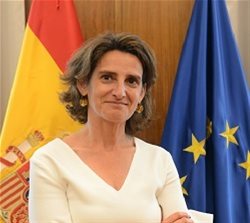Europe and Spain must ensure cohesion, social and territorial justice

Teresa Ribera Rodríguez, Third Vice-President of the Government of Spain and Minister for the Ecological Transition and the Demographic Challenge
One of the great challenges facing Spain and much of Europe is to ensure cohesion and social and territorial justice. As part of this aspiration, the spatial distribution of resources is emerging as a fundamental tool for achieving the full exercise of rights and opportunities throughout the territory, and thus for revaluing one of our main assets, our rural environment. In Europe, as in Spain, there are growing inequalities between places and people as a result of an economic and social development model of concentration that is unjust and unsustainable.
The Spanish population continues to grow, but it tends to concentrate in large urban areas, resulting in an increasingly acute territorial imbalance. As a result, around 90 % of the population is spread over 30 % of the territory, resulting in a density that is clearly below the EU average. This gap between urban areas and territories with rural or less populated municipalities translates into a difference in opportunities depending on the place of residence. Factors such as territorial dispersion, depopulation, loss of young talent, ageing, low birth rates or masculinisation of the territory provide evidence of the lack of territorial cohesion and inequalities that have a negative impact on society as a whole.
The problems of territories at risk of depopulation have occupied the political and media agendas with great intensity in recent years; however, it was not until the constitution of the current government of Spain that the demographic challenge and the fight against depopulation became one of the priorities for national action. The creation of the Ministry for the Ecological Transition and the Demographic Challenge, with the rank of vice-presidency, has been key to shaping current national public policy to address these matters.
This gap between urban areas and territories with rural or less populated municipalities translates into a difference in opportunities depending on the place of residence.
Moreover, evidence of the progress achieved can be found in the actions carried out by the ministry, such as, among other initiatives, the implementation of the recovery plan comprising 130 measures to face the demographic challenge, with a budget of more than EUR 13.13 billion; the creation of a specific line of territorial financing, the Territorial Cohesion and Transformation Fund; the annual calls for grants to finance innovative projects; the promotion of local bioeconomy entrepreneurship for the sustainable use of endogenous resources and restoration work in areas that have suffered forest fires; rural digital training; the mobilisation of young talent through the rural campus programme, which offers paid internships for university students; the incorporation into the ERDF of funds to meet political objective 5.2 for a Europe closer to its citizens, promoting the integrated and sustainable development of all types of territories and local initiatives; the creation of a Network of Territorial Innovation Centres as a platform for national public–private collaboration and the forum of companies with rural commitments.
Efforts to implement public policy have focused on designing a new organisational structure based on a multilevel governance model with a multisectoral approach, with representation of the Government of Spain, the Self-governing Regions and local entities. In addition, public participation has been guaranteed through the Territorial Cohesion Forum and collaboration with highly representative associations with proven knowledge of the country’s territorial needs.
Public participation has been guaranteed through the Territorial Cohesion Forum and collaboration with highly representative associations with proven knowledge of the country’s territorial needs.
In line with the work carried out on EU cohesion policy, as evidenced in the European Commission’s Eighth Report on Economic, Social and Territorial Cohesion, the Spanish Presidency of the Council of the European Union is an opportunity to complete the Territorial Agenda 2030 and reinforce complementarities with other EU policies, in order to:
Address the demographic challenge as part of the EU’s commitments in the framework of the ecological and digital transitions;
Promote actions to structure the territory at European level to cope with demographic changes, generate more opportunities for rural areas and regions in demographic decline and ensure social inclusion, starting with the territorial, social and economic imbalances between rural and urban areas;
Promote and develop public policies on socioterritorial cohesion that complement traditional sectoral policies by providing a cross-cutting vision;
Promote urban–rural links by taking a functional approach to the integrated development of the territories, and promote the revaluation of the rural environment as a space for economic reactivation and innovation.
In short, the experience accumulated by this ministry has revealed the need to rethink approaches to the territory from the point of view of functionality and to generate opportunities to achieve a comparable quality of life for all citizens, aiming to reduce territorial vulnerability.
This will require action that rethinks the relationship between urban and rural environments and is able to reverse the historical inertia of metropolis agglomeration that is implicit in the depopulation of rural areas. It must incorporate innovative and transformative formulas that allow us to rebuild the relationship with rural territory.
This task will be promoted during the Spanish Presidency of the Council of the European Union to ensure the full effectiveness of citizens’ rights to generate active, inclusive and functional territories.